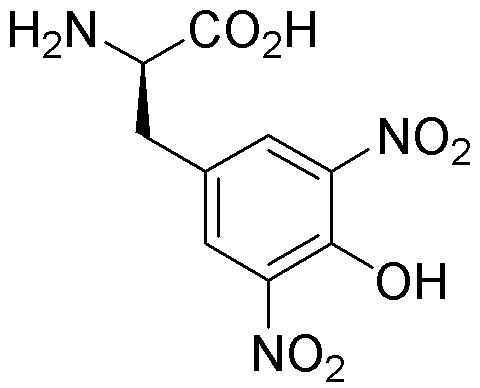3,5-Dinitro-D-tyrosine is widely utilized in research focused on
- Pharmaceutical Development: This compound serves as a key intermediate in the synthesis of various pharmaceuticals, particularly those targeting inflammatory diseases due to its unique nitro groups that can modulate biological activity.
- Biochemical Research: Researchers use it to study protein modifications and interactions, as the dinitro group can influence protein structure and function, providing insights into enzyme activity and receptor binding.
- Analytical Chemistry: It is employed as a standard in analytical methods, such as HPLC, to quantify amino acids and assess the purity of pharmaceutical compounds, ensuring quality control in production.
- Immunology Studies: The compound is used in the development of immunoassays, helping to create antibodies that can detect specific proteins or pathogens, which is crucial for diagnostics and vaccine development.
- Material Science: Its properties make it suitable for creating novel materials with specific chemical functionalities, which can be utilized in coatings and polymers that require enhanced durability and resistance to environmental factors.
General Information
Properties
Safety and Regulations
Applications
3,5-Dinitro-D-tyrosine is widely utilized in research focused on
- Pharmaceutical Development: This compound serves as a key intermediate in the synthesis of various pharmaceuticals, particularly those targeting inflammatory diseases due to its unique nitro groups that can modulate biological activity.
- Biochemical Research: Researchers use it to study protein modifications and interactions, as the dinitro group can influence protein structure and function, providing insights into enzyme activity and receptor binding.
- Analytical Chemistry: It is employed as a standard in analytical methods, such as HPLC, to quantify amino acids and assess the purity of pharmaceutical compounds, ensuring quality control in production.
- Immunology Studies: The compound is used in the development of immunoassays, helping to create antibodies that can detect specific proteins or pathogens, which is crucial for diagnostics and vaccine development.
- Material Science: Its properties make it suitable for creating novel materials with specific chemical functionalities, which can be utilized in coatings and polymers that require enhanced durability and resistance to environmental factors.
Documents
Safety Data Sheets (SDS)
The SDS provides comprehensive safety information on handling, storage, and disposal of the product.
Product Specification (PS)
The PS provides a comprehensive breakdown of the product’s properties, including chemical composition, physical state, purity, and storage requirements. It also details acceptable quality ranges and the product's intended applications.
Certificates of Analysis (COA)
Search for Certificates of Analysis (COA) by entering the products Lot Number. Lot and Batch Numbers can be found on a product’s label following the words ‘Lot’ or ‘Batch’.
*Catalog Number
*Lot Number
Certificates Of Origin (COO)
This COO confirms the country where the product was manufactured, and also details the materials and components used in it and whether it is derived from natural, synthetic, or other specific sources. This certificate may be required for customs, trade, and regulatory compliance.
*Catalog Number
*Lot Number
Safety Data Sheets (SDS)
The SDS provides comprehensive safety information on handling, storage, and disposal of the product.
DownloadProduct Specification (PS)
The PS provides a comprehensive breakdown of the product’s properties, including chemical composition, physical state, purity, and storage requirements. It also details acceptable quality ranges and the product's intended applications.
DownloadCertificates of Analysis (COA)
Search for Certificates of Analysis (COA) by entering the products Lot Number. Lot and Batch Numbers can be found on a product’s label following the words ‘Lot’ or ‘Batch’.
*Catalog Number
*Lot Number
Certificates Of Origin (COO)
This COO confirms the country where the product was manufactured, and also details the materials and components used in it and whether it is derived from natural, synthetic, or other specific sources. This certificate may be required for customs, trade, and regulatory compliance.


